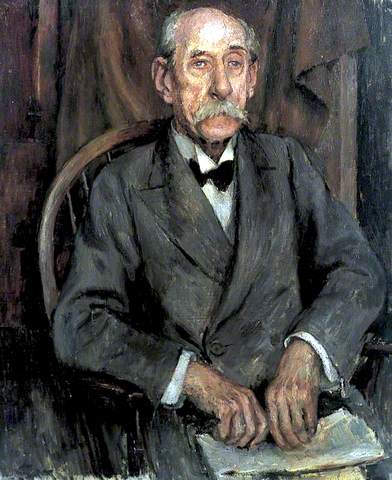PETTIWARD, Roger Gamlen
As Roger Gamlen Terry, he was born at Onehouse Lodge, Onehouse, near Stowmarket, Suffolk, on 25 November 1906, eldest of the two sons, his younger brother was cartoonist Daniel Pettiward, and two daughters of Charles Terry (1855-9 October 1933) and his wife, Eliza Mary née Gamlen (10 December 1880-26 February 1952), daughter of Robert Heale Gamlen of New Place, Welwyn, who married Charles Terry at St Mary's Church, Welwyn, Hertfordshire on 26 April 1904. His father Charles Terry took the surname Pettiward by royal licence in 1908 to inherit the estate of his great uncle, Robert John Pettiward (formerly Bussell 1821-3 February 1908) of Finborough Hall, Suffolk. Roger was educated at Wixenford School 1915–1919, Eton College 1919–1925, and Christ Church, Oxford 1925–1928. He took a degree in agriculture and later a course in farm management, aiming to take over his father's estate at Finborough, but he finally decided on art. He studied art at Vienna 1928–1929, Munich 1929–1930, Slade School of Fine Art, London 1930–1932 and in Paris. On the death of his father in 1933, he inherited the Finborough estate and married at St Bartholomew's Church, Smithfield on 1 July 1935, Diana Berners-Wilson (27 March 1910–18 May 2000), daughter of Frederick Berners-Wilson of the Hardwick, Abergavenny, whom he had met at the Slade, and they had one son, who was born at Finborough Hall in 1936, and two daughters. In 1936 he sold his Finborough Hall estate and went to live at his other estate at Highgate, London and in 1938 commissioned Tayler and Green to design a house in Highgate, a three-storeyed, open-plan modern house 'The Studio House', Duke's Head Yard, Highgate High Street, London which is currently a listed building. From 1935 and the beginning of the war in 1939, he contributed humorous drawings regularly to 'Punch', 'Night and Day' and 'London Week', signing these humorous drawings with a whorl, because he wanted his name to be associated only with fine art. The editor of 'Punch' advised him to sign his work with a name and he chose 'Paul Crum' but many continued to be signed with the whorl or not at all. Pettiward continued all the time to paint witty, quirky, and humorous subjects, from models and from nature, exhibiting principally at the Leicester Galleries in London and at New English Art Club; the Royal Society of British Artists and elsewhere. The only collection of Pettiward's drawings so far published is 'The Last Cream Bun' (1984), the title being taken from one of the captions, which contains over 100 drawings. On 5 March 1940, he was gazetted to the Bedfordshire and Hertfordshire Regiment and was killed in the Dieppe raid on 19 August 1942, leading a troop of No. 4 commandos attacking the German heavy gun battery at Varengeville to the west of Dieppe. Pettiward, who lived at The Causeway, Braughing, Hertfordshire, has no known grave but was commemorated, together with fifteen other commando dead, on a plaque in the village square of Ste Marguerite, near Varengeville and left an estate valued at £137,894. His wife remarried at Abergavenny, Monmouthshire in 1950, Arthur Jack Herbert.
Works by This Artist

|
Nocturnal PuttersOil on panel
|

|
Punch CartoonBy Paul Crum |

|
Officer in St. James ParkPen, ink, and watercolour
|

|
Portrait of a ManOil on canvas
|